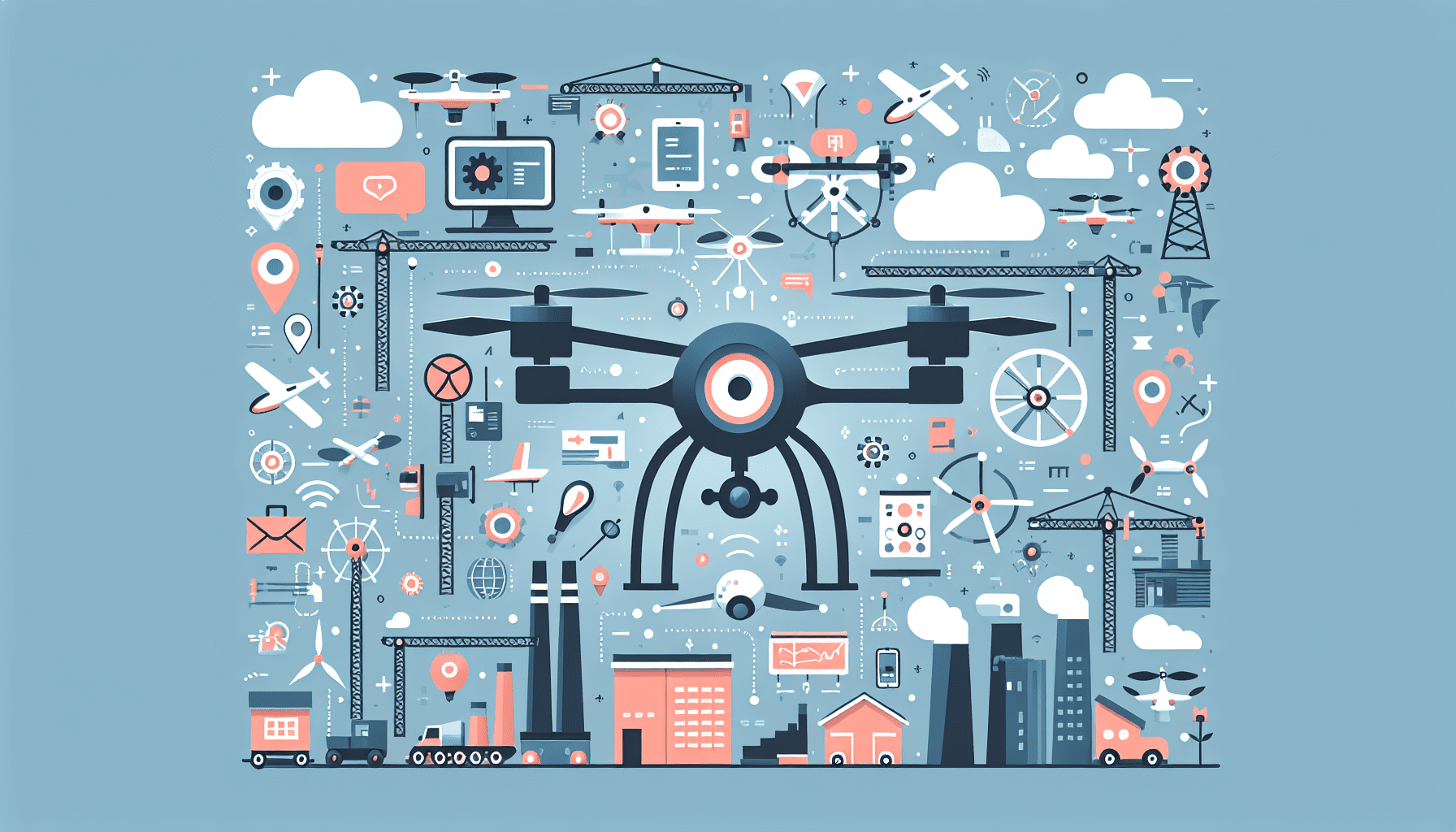Drone Technology is Transforming Global Industries
In This Article
- Drone technology is revolutionising industries by increasing efficiency and reducing operational costs.
- Agricultural drones provide real-time insights to optimise crop yield and sustainability.
- Film, logistics, and emergency services benefit immensely from fast, flexible drone deployment.
- Energy inspections and urban planning rely on drones for data collection and structural analysis.
- Environmental monitoring with drones enables safe and detailed ecosystem surveillance.
- Challenges include regulation, trust, and the cost of infrastructure integration.
- Future developments include swarm drones, urban air mobility, and AI-powered analytics.
- Cross-sector collaboration is key to fully realising the potential of drone technology.
How Drone Technology Is Shaping the Modern World
Innovation Across Sectors
Drone technology has rapidly evolved from its initial military and recreational applications to become a cornerstone across various industries. Today, innovative drone systems support everything from precision agriculture to emergency medical deliveries in underserved areas. By integrating advanced sensors, machine learning algorithms, and high-resolution imaging, drones provide real-time data and autonomous operations that were previously unimaginable.
The commercial advantages of drone technology are profoundly evident. Businesses are using drones to reduce labour costs, improve safety, and collect actionable insights with unprecedented speed. Whether it’s a telecom company inspecting towers or a filmmaker capturing aerial shots, drones are adding exceptional value. Their ability to bypass traditional limitations such as terrain or access barriers makes them invaluable. As regulations become more favourable and technology continues to mature, the scope of drone technology is only expected to broaden.

Drones in Agriculture
Precision Farming and Yield Optimization
In the agricultural sector, drone technology has introduced a paradigm shift known as precision farming. Farmers now deploy drones equipped with multispectral and thermal sensors to monitor crop health, assess soil conditions, and optimise irrigation. Rather than relying on traditional, manual inspection methods, drones offer high-frequency, high-resolution data that enable predictive insights. This significantly improves decision-making, ultimately resulting in increased efficiency and higher yields.
Moreover, drone technology helps reduce the environmental footprint of agricultural practices. By enabling targeted pesticide application and efficient fertiliser use, drones contribute to sustainable farming. They make it feasible for smaller farms to adopt practices once exclusive to large-scale operations. Numerous studies have shown that the use of agricultural drones can cut down both time and cost by at least 30%, a remarkable feat in a demanding industry.
“Drones have allowed us to farm smarter, not harder, by giving us insights we never had before.” – Agricultural Technologist
Drones in Filmmaking
Changing the Way Stories Are Told
Drone technology has dramatically transformed cinematic storytelling by offering perspectives that were either cost-prohibitive or logistically impossible. Directors and cinematographers utilise drones to create sweeping aerial shots, dynamic tracking sequences, and smooth transitions between scenes. The versatility of drones not only enriches visual storytelling but also enhances production value without the need for cranes or helicopters.
Furthermore, the portability and flexibility of drones allow for capturing elite footage in remote and rugged locations. Whether it’s an alpine summit or a bustling urban centre, drones operate with minimal crew and setup time. As drone camera resolutions continue to advance and gimbal stabilisation becomes more refined, filmmakers have found drones to be a budget-friendly and creatively liberating innovation. It is no surprise that drone cinematography has become a staple in both indie projects and major productions alike.
Logistics and Delivery Disruption
Speed, Reach, and Safety
Perhaps one of the most high-profile applications of drone technology is within the realm of logistics and delivery services. Companies like Amazon and UPS are actively trialling programmes that utilise drones to deliver parcels within minutes. Especially in rural or congested urban landscapes, drones bridge the last-mile delivery problem—offering swift, contactless solutions that traditional vehicles fail to match.
Medical logistics have seen even more profound advancements. Drones now deliver vital supplies such as vaccines, blood samples, and emergency medications to remote villages and disaster zones. The speed and reliability of drone delivery are not only reshaping service expectations but also saving lives. Enhanced battery life, AI-driven flight navigation systems, and real-time tracking continue to improve drone performance in this crucial sector.
Drone Use in Emergency Response
Saving Lives Through Aerial Support
In emergency scenarios, response time is of the essence. Drone technology significantly accelerates aid and improves situational awareness. Firefighters and rescue teams deploy drones to identify hotspots, locate victims, and assess structural integrity after earthquakes or floods. Drones can access hazardous or collapsed areas that are too dangerous for humans, delivering vital reconnaissance footage within seconds.
Search and rescue drones equipped with infrared cameras have revolutionised night-time operations and scenarios involving poor visibility. These unmanned aerial vehicles provide critical support that traditional tools simply cannot. Drones also facilitate the coordination of ground personnel by offering a bird’s-eye view, making it easier to formulate efficient response strategies. As such, drone integration in emergency protocols is rapidly gaining traction across the globe.
Energy and Infrastructure Inspection
Minimizing Risk and Cost
Maintenance of energy and infrastructure assets—such as power lines, wind turbines, and pipelines—has traditionally required human inspectors to conduct precarious and costly checks. Drone technology mitigates these challenges by offering a versatile, safe and cost-effective alternative. Drones equipped with zoom and thermal cameras can inspect hard-to-reach or hazardous components with surgical precision, all while keeping workers out of harm’s way.
Furthermore, using autonomous flight paths and AI-driven anomaly detection, drones can swiftly scan large installations and highlight problem areas for further analysis. This process reduces downtime and ensures consistent performance, especially in critical infrastructure projects. Utility companies worldwide are investing in drone fleets, recognising their long-term benefits in risk management and operational efficiency.
Real Estate and Urban Planning
Redefining Visual Data Gathering
Drone technology has rapidly become integral to real estate marketing and urban planning. High-resolution aerial imagery and 3D mapping allow realtors to showcase properties in immersive ways that traditional photography cannot achieve. Potential buyers can now explore neighbourhoods and surroundings even before a physical visit, enhancing transparency and convenience.
On the urban development side, planners use drones for land surveys, traffic analysis, and construction monitoring. By providing accurate geospatial data, drones support informed zoning decisions and infrastructure design. These applications lead to better urban solutions that accommodate growing populations and environmental considerations. The ability to gather data quickly and regularly makes drones a real asset in long-term urban strategy implementation.
Environmental Monitoring with Drones
Tracking Change and Wildlife Safely
Environmental researchers are increasingly turning to drone technology for its capacity to monitor ecosystems with minimal intrusion. Drones are ideal for tracking wildlife migrations, surveying forests, and mapping coastal erosion—all without endangering species or the researchers themselves. With sensors that can detect chemical leaks, temperature changes, and even air quality, drones provide comprehensive environmental oversight.
In the context of climate change, drones play a pivotal role in glacier mapping, flood prediction, and monitoring agricultural runoff. Scientists rely on drones for their agility, cost-effectiveness, and ability to cover vast areas in a single flight. This kind of data fidelity and breadth was practically unachievable before drone technology became mainstream. Conservation efforts benefit immensely, as timely and accurate information is crucial for preserving our natural habitats.
Challenges of Drone Adoption
Compliance, Trust, and Integration
Despite its many benefits, drone technology faces several barriers to universal adoption. Regulatory compliance is the foremost challenge, as aviation authorities across nations struggle to keep pace with technological developments. Strict licencing, airspace restrictions, and limited flight permissions often hinder commercial use.
Public distrust is another obstacle, particularly around issues of privacy and safety. Frequent news about drone misuses leads to anxiety among communities, many of whom are still unsure about data security and surveillance. Moreover, widespread integration requires significant investment in training and infrastructure. Companies must build robust data systems that can effectively incorporate the outputs of drones into day-to-day decision-making. Addressing these challenges is critical for unlocking the full potential of drone innovation.
The Future of Drone Technology
Trends and Expectations Ahead
The future of drone technology looks promising, with multiple emerging trends suggesting even broader adoption. Swarm technology—wherein multiple autonomous drones work collaboratively—is undergoing active research and pilot testing across logistics and defence sectors. Equally intriguing is the integration of 5G connectivity, enabling more stable real-time data transmission and remote operation over vast distances.
Urban air mobility, including passenger drones, is no longer science fiction. Companies are developing drones capable of carrying people or large cargo, aiming to relieve congested transport networks. Additionally, machine-learning algorithms are making drones smarter every day, allowing for sophisticated analytics and real-time decision-making. As drones become more intelligent, affordable, and legally supported, their presence in our daily lives is set to accelerate markedly.
Conclusion: The Sky Is Just the Beginning
From agriculture to urban development, drone technology is reshaping how we interact with our environment and industries. Its adaptability, cost-effectiveness, and data-gathering capabilities make it a transformative force. While challenges remain in regulation and public acceptance, the benefits far outweigh the drawbacks. As innovation continues, drone technology will undoubtedly become more ingrained in our personal, commercial, and civic experiences. Leaders, developers, and policymakers must work together to ensure this powerful tool is deployed responsibly and sustainably.
Great guide on how-drone-technology-is-revolutionizing-various-industries – Community Feedback
Which industries are most impacted by drone technology?
Key industries such as agriculture, filmmaking, logistics, real estate, and emergency services are seeing major transformations with the integration of drone technology.
How are drones used in modern agriculture?
Drones help monitor crops, optimize irrigation, and assess soil health, improving efficiency and crop yields for farmers.
What are some benefits of using drones in industry?
Drones offer cost savings, enhanced safety, improved data collection, and increased efficiency across sectors.

